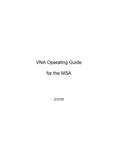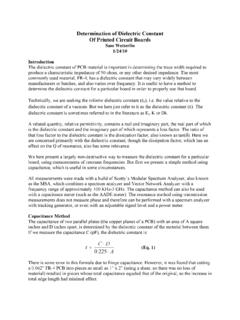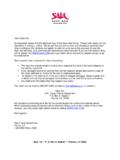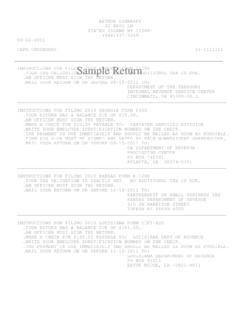Transcription of MANUAL RETURN LOSS MEASUREMENTS Sam …
1 MANUAL RETURN loss MEASUREMENTSSam paper describes the procedure for using a reflection bridge (a/k/a RETURN loss bridge ) to manually measure RETURN loss (easily converted to SWR if desired). MANUAL means we don t have all the automation of a vector network analyzer, and we also can t utilize elaborate calibration to improve accuracy. The measurement procedureThe basic setup is shown in Figure 1 Basic Setup DUT is the device under test; it receives a signal andreturns a need a signal source, whose frequency we must set manually, and we need a way to measure the output level in dbm, which we will have to record manually. It is possible to get some automation by using a sweep generator; more on this bridge routes the input signal to the DUT and outputs a signal proportional to the reflection received from the DUT.
2 The bridge itself can take various forms. One such bridge is decribed later. For the moment, suffice it to say that it is not difficult to build a reflection bridge which can isolate the reflection well enough to measure RETURN losses in the range 0-30 db with as much accuracy as we generally need. We use a type of calibration called reference calibration , whereby we establish a reference output level representing zero RETURN loss , attach the DUT, and compare the DUT reflection level to the reference level. For example, if the reference level is -2 dbm, and the output with the DUT attached is -23 dbm, the RETURN loss is 21 dbm. The reference is established by using two measurement standards: an open and a short.
3 The open is a coax connector whose backside has nothing attached. The short is a connector whose backside is directly shorted by a metal strip or disc connecting the center pin to the body of the connector. Of course, we can get an open circuit by not attaching anything to the output connector, but at higher frequencies the short transmission line represented by the open connector has some effect, and we want the distance to the actual point of the open circuit to be about the same as the distance to the actual short. Below a couple hundred MHz, we probably don t actually need to attach an open get a reference level representing zero RETURN loss , we can just measure the output with the open standard attached.
4 An open circuit has a RETURN loss of zero. A short circuit also has a RETURN loss of zero (meaning 100% reflection), but the phase of the reflection is 180 degrees different between an open and a short. Because we are not measuring phase ( RETURN loss is a scalar quantity), the output with the open and short attached should look identical, in theory. In practice, there will generally be some difference between the open and short reflection outputs, though it is often less than db. To reduce error, we can use as the reference level the average between the open and short outputs. But if we have verified that the open/short difference is less than 1 db, this averaging will give us a reference only db from what we would get using the open reflection as the reference level, so the averaging may not be worth the bother.
5 What are we measuring? RETURN loss is derived from the voltage of the signal reflected by a device under test (DUT). If we know the voltage of the signal sent to the DUT and the voltage of the reflection, the reflection coefficient is the ratio of the reflected signal to the incident signal:Reflection Coefficient = = Reflected Voltage/Incident VoltageThat ratio is what we will use to measure the reflection coefficient. Another formula, useful when you know the impedance of the DUT, is as follows:Reflection Coefficient = 00 ZZZZ+ = Z=DUT impedance; Z0=Reference Impedance (here, 50 ohms)We will always use a reference impedance of 50 ohms loss is the magnitude of that reflection coefficient expressed in decibels as a non-negative number: RETURN loss = 20*Log(| |)(Since | |<=1, RETURN loss will be non-negative)In our case, the conversion into decibels is done automatically by the instrument measuring the bridge output, as that instrument will measure in are the technical formulas, but what does a given level of RETURN loss actually mean?
6 RETURN loss can be translated into SWR, or into the percent of power reflected by the DUT, or, roughly, into impedance. Table 1 shows those values for various levels of RETURN 1 Translating RETURN loss to reflection coefficient, SWR,percentage of power reflected, and equivalentresistance, one greater than and one less than 50 correspondence of RETURN loss and impedance deserves a little more attention. Any given RETURN loss can be generated by a variety of impedances; each such impedance generates the same magnitude of reflection coefficient, but different phases. Since RETURN loss is a scalar quantity, it does not include the phase, so all those impedances generate the same RETURN loss .
7 Figure 2 shows the impedances that generate a reflection coefficient whose magnitude (denoted by [rho]) is , corresponding to a RETURN loss of 2-Impedances which generate a reflection coefficientwith magnitude of ( RETURN loss of db).There are two pure resistance values which create any finite RETURN loss . As shown in Figure 2, if the lower one is 50/N (N=2 in this case), then the higher one is 50*N. As the reflection coefficient decreases ( RETURN loss increases), the circle gets smaller and smaller and its center moves closer and closer to 50 ohms. Therefore, RETURN loss can be thought of as a measure of how close the impedance is to 50 much accuracy do we need?3As a preliminary matter, we should explore how much accuracy we need when measuring RETURN loss .
8 One way of looking at RETURN loss is that it measures the amount of power reflected by the DUT. Generally, if the DUT has RETURN loss of 20 db or better (higher), it is reflecting so little power (1% of the incident power) that it does not really matter exactly how little it is. On the other hand, if a DUT reflects half or more of the power reaching it ( RETURN loss of 0-3 db), we may just consider it to be unacceptable, without having to know exactly how much it reflects. So if we know the RETURN loss is higher than 20 db or lower than 3 db, that may be all we need to know. And even for values in the 3-20 db range, errors of several db may not be we look at RETURN loss as an indirect measure of impedance, high RETURN losses mean the DUT has an impedance close to 50 ohms.
9 For example, as shown in Table 1, resistances between and ohms have RETURN losses of 30 db or higher. If we consider such a DUT equal to 50 ohms, we have a possible 6% error. For many purposes, that is all the accuracy we need, so in many cases verifying that the RETURN loss exceeds 30 db is all we need to know, and there is no point to trying to determine whether it is actually 40 db, 50 db, or infinity. RETURN losses that are near zero indicate impedances that are far from 50 ohms. For example, resistances of 3 ohms and 870 ohms have RETURN losses of 1 db. Getting the RETURN loss exactly right in that situation does not help us much, since we are left with two wildly different resistances that may have that RETURN loss , and we have no way to choose which is correct, since we lack phase information.
10 In fact, as noted earlier, the impedance may have a reactive component as well, and there is an entire circle on the impedance plane of possible DUTs with a RETURN loss of 1. When you look at RETURN loss as a measure of impedance, it tells you whether you are close or far from 50 ohms; if you are close you have a good idea what the impedance is; if you are far away you don t even know what direction you are from 50 ohms, so you know you have a problem, but you re not sure exactly what it RETURN loss is a scalar value, we cannot determine the exact impedance even if we knew the exact RETURN loss . Phase information would be required. Our MANUAL use of the bridge provides only scalar information, and is effectively a scalar network analyzer , as opposed to the fancier vector network analyzers , which provide phase information (magnitude combined with phase = vector).









